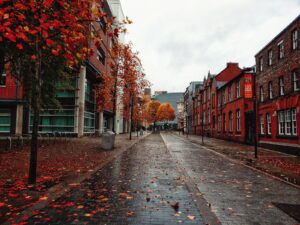One determined ecologist has reintroduced tens of native flora species to hundreds of acres. Here’s what she has learnt in the process.
Sally Phillips has been a passionate environmentalist almost as long as she can remember. At least since the first time she stopped to think about how we treat our planet.
‘Using materials and resources more quickly than the Earth can replenish them, to not recycle, to pollute. It all just seems like a really stupid thing to do,’ she tells us over the phone. ‘I’m 55 now and have felt this way since I was a teenager. So I’ve gone from one profession to another, kind of didn’t know what I wanted to do when I was younger, but one thing has led to the next.’
For years, she worked as an ecologist specialising in bats, before developing the prototype Chimney Sheep, a unique draught excluder which can signicantly improve energy performance and has grown into a very successful business with a turnover of around £2million. Profits from this were then used to invest in land at Bassenthwaite, Cumbria, where, alongside husband Darren, she oversaw the planting of 25,000 trees.
‘We got the first seven-acre site and got that all planted out… but then what happens? It’s such a lot of work to get the trees in, nurture them. If you’re planting trees, you’re in it for the long term. I was a bat ecologist before, so I want these trees to be roosts in 400 years time,’ Phillips tells us.
A process that began in earnest three years ago has developed and expanded significantly. One of the most significant changes has been the establishment of a Community Interest Company [CIC], which she appropriately named Buy Land Plant Trees.
‘[A CIC] means the assets are locked. You can set out what you want the land for if you’re no longer around,’ she says, explaining this process was relatively simple and means even in the worst case scenarios, for example the death of company directors of the business itself, land and trees will be passed to the WoodlandTrust. ‘We needed to make sure it was asset locked, so future descendants wouldn’t try and sell the timber or anything like that. I consulted and took advice on whether to establish a charity or CIC, but with a Community Interest Company you’ve got more control.’
A second piece of land in the Lake District soon followed, along with another 25,000 trees, this time over a 13-acre plot. Once complete, a new opportunity presented itself, with 160-acres of hilly terrain at Low Fell available at auction. Efforts on this huge expanse mean the company has now been responsible for planting 290,000 saplings. It’s a huge achievement worthy of headlines, and the process involved is also drawing attention from environmental experts.
‘We’re planting in dense clusters, without stakes. The trees sort of support one another, but also compete. By putting in a good mix this approach works – we kind of plant and go, let them fend for themselves,’ says Phillips. ‘We really want nature to take its course, we don’t want to micromanage; things grow, let them grow, we won’t fiddle about, prune, garden. Just let the woodland get established and then do its thing.
‘They’re all native species. Low Fell itself has two elements, upland and lowland. Upland is moorland, so there we have Downy Birch, Hawthorn, Blackthorn, we’re reintroducing aspen, which would have occurred there naturally, years ago, but it’s all gone,’ she continues. ‘Birch Willow, Grey Willow, Goat Willow… a lot of standard trees, but bringing in others that wouldn’t necessarily get here on their own. Sort of anticipating climate change, adding in Juniper, Yew, Holly, Field Maple, Small-Leaved Lime, Wayfaring Tree, Tea-leaved Willow.’
Tellingly, many species have been selected for resilience, with drought resistance one of several priorities given increasingly high summer temperatures and longer periods of low rainfall are becoming commonplace in Britain. Overall, around 30 different types have been used, including Scots Pine, Dogwood, Guelder Rose, Crab Apple, Hazel, Rowan, Alder, Wild Cherry and Sessile Oak.
The existing land is just as significant in terms of how the project is set to grow, and another reason so many climate and nature professionals are watching with keen eyes. Trees are being planted in and among bracken, which Phillips describes as ‘quite domineering’.
The tall ferns restrict the amount of sunlight reaching saplings, but also protect from grazing animals such as deer, and ensure flora is kept moist all year round. As the new trees rise, they eventually overshadow foliage below, leading to natural die-back, bringing the landscape back into balance.
Our conversation moves to resourcing and cost since work at Low Fell began. Unsurprisingly, this is difficult to gauge, although a subsequent breakdown from Phillips clears up some details. The plot itself was bought for £146,000, with an additional £5,000 spent on legal fees. Since then, £190,000 has been invested in various ways, with £40,000 spent on fencing alone, ensuring the site is protected from livestock. Expenses that would have been impossible without external support.
‘We’ve been fortunate to receive donations from the Woodland Trust, Cumbria Wildlife Trust, The Conservation Volunteers [TCV], and private individuals have donated trees. Buying land was the difficult bit, and securing it,’ Phillips says, estimating around 160,00 trees have been donated. ‘We’ve had a Woodland Creation Grant, which will pay £180,000 over 10 years. So it’s generous, but we’re having to find a lot upfront. Also the organisation will only pay for trees with two-metre spacing, so that would be 39,000 in the area we are using. We want 130,000 in that space, so there’s a shortfall.’
Work itself doesn’t come cheap, either. Although it’s clear the team ‘really enjoy volunteer days’, we’re left under no illusion that professionals are needed. ‘We use contractors,’ Phillips says, telling us NW Forestry handles most of the heavy lifting. ‘Getting trees into the ground is hard, so we can’t expect volunteers to carry heavy bags of trees up a mountain and work away in all weather. Finding the right contractors, who are sympathetic to how you want to do things, is important.’
‘Patience is also important. I mean the Woodland Creation Grant was applied for two years ago. And we’re not patient. I was 54 then, I’m 55 now and just want to get on with things,’ she continues. ‘If I’d waited for the grant we’d have lost two seasons of growth for the first trees we planted. But this meant that land wasn’t eligible for a grant, so you really have to think about these things. Do the research. There are all kinds of grants available at the moment and it can be really complicated. But there are bodies set up to help. The Rivers Trust helped us with a grant application, for example. If they hadn’t, we’d still be filling the forms out now.’
Images: Buy Land Plant Trees / Sally Phillips
More features:
Sustainable supermarket choices: Easter, electrified deliveries, and food banks
Biodiversity Net Gain is now active policy, here are its limitations
















